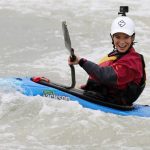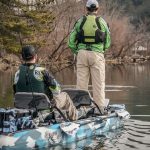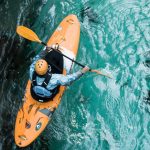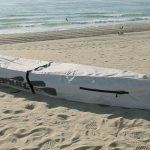If you start kayaking beyond the bounds of sunny weather and sheltered water, you will quickly realize the value of a good spray skirt.
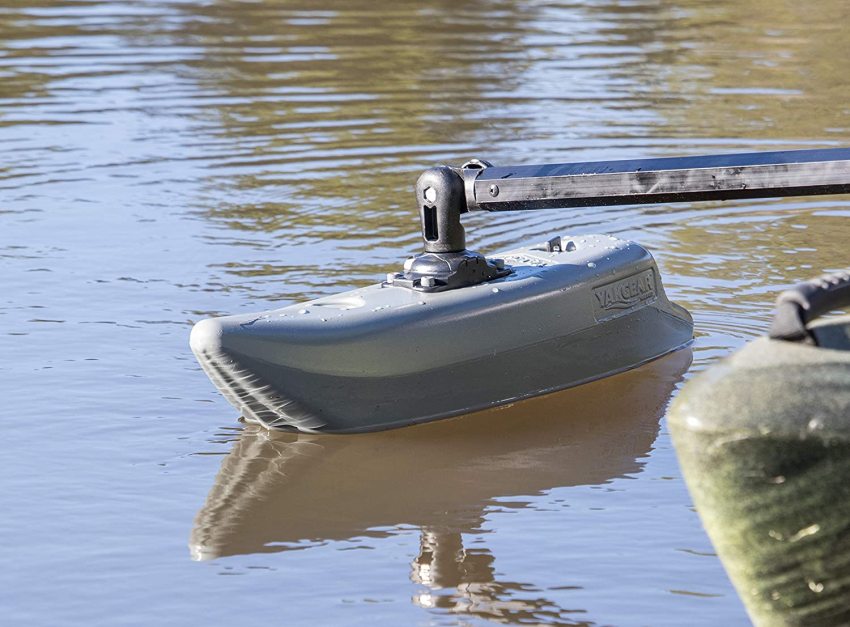
Below, we’ve compiled a list of the best kayak outriggers, along with an in-depth guide on how to choose a kayak stabilizer, what to look for, and more.
We could all use a bit more stability in our lives! And I’m not talking about emotional stability (though that’s good, too!).
I mean the sort of stability that keeps your kayak from tipping over when you’re casting out a line, reeling in a struggling fish, shooting at a duck flying overhead, or balancing against big waves.
A lot of kayaks are built for higher primary stability, meaning they are incredibly stable on flat, calm water. But when things get choppy, they get tippy.
Other kayaks have great secondary stability, so they can tilt and tip on their sides in rough water without capsizing. But when the water is calm, they’re wickedly unsteady.
Adding a kayak outrigger can be a game-changer for maxing out your stability. With a pair of outriggers, also called kayak stabilizers or kayak pontoons, you’ll have a lower risk of tipping over, no matter what.
Trust me, once you’ve kayaked with an outrigger—whether fishing, hunting, or overseas expedition paddling—you’ll never look back!
As an affiliate of Amazon and other retailers, we may earn a small commission when you buy via our links, at no additional cost to you. Thank you!
Quick Answer: The Best Kayak Outriggers for You
Don’t have time to read the entire article? Don’t sweat it! Here’s our list of the best kayak outriggers for you to consider:
- Hobie Sidekick Ama Kit
- YakGear Kayak & Canoe Outriggers (Generation 2)
- Scotty Kayak Stabilizer System
- Spring Creek Manufacturing Hydrodynamic Canoe Stabilizer Float Package
- Wave Armor KAYAK / CANOE STABILIZER KIT
- Wingman The Cargo Outrigger
- Brocraft Kayak Outriggers
Comparison Table: Best Kayak Outriggers
| Model | Specs | Where to Buy |
 Hobie Sidekick Ama Kit | Materials: Aluminum frame, PVC floats Length: 31.5″ Weight: 6 lbs. | Amazon |
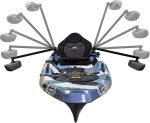 YakGear Kayak & Canoe Outriggers (Generation 2) | Materials: Aluminum arms, hard plastic float base Length: 30″ Weight: 6.8 lbs. | Amazon |
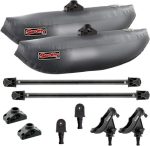 Scotty Kayak Stabilizer System | Materials: Anodized aluminum arms, PVC bladder float base Length: 34″ Weight: 10 lbs. | Amazon |
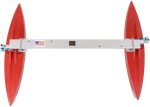 Spring Creek Manufacturing Hydrodynamic Canoe Stabilizer Float Package | Materials: Aluminum crossbar, sturdy plastic floats Length: 37″ Weight: 15 to 16.5 lbs. | Amazon |
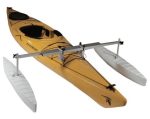 Wave Armor KAYAK / CANOE STABILIZER KIT | Materials: Aluminum frame, stainless steel components, polyethylene floats Length: 43″ Weight: 20 lbs. | Wave Armor |
 Wingman The Cargo Outrigger | Materials: Aluminum frame, heavy-duty polyester webbing Length: 20.5″ Weight: Unspecified | Wingman Outfitter |
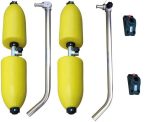 Brocraft Kayak Outriggers | Materials: Aluminum arms, PVC floats Length: 32″ Weight: 9 lbs. | Amazon |
Best Kayak Outriggers
Hobie Sidekick Ama Kit
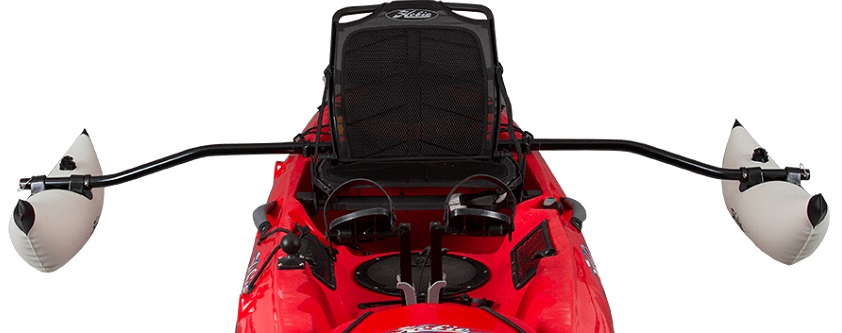
Materials: Aluminum frame, PVC floats
Length: 31.5 inches (80 cm)
Weight: 6 lb (2.5 kg)
For anyone with a Hobie kayak, this outrigger is the perfect option. Its inflatable design makes it easy to store and transport, but all it takes is a few quick puffs of breath and you’re ready to get paddling. Thanks to its sturdy aluminum arms, it’s rust-resistant, strong enough to use with a full-size kayak sail, and more than capable of keeping you steady and stable in choppy water.
The outrigger can be adjusted with a twist-and-click between three positions (low, medium, and high), so you can adapt it to the right configuration for your specific paddle length and stroke. It comes with all the hardware needed to mount it to your Hobie kayak (including bolts and expanding nuts), though it will require “adapter plate 72062061” for a solid mounting.
Negative reviews commented that the arm length wasn’t quite enough to keep it out of the way of a paddling stroke, and one user actually had to DIY modify the system to make it fit their specific Hobie model.
What We Like:
- Sturdy and well-built
- Compatible with most Hobie kayaks
- Easy to mount with the provided hardware
- Adjustable height, twist and click in seconds
What We Don’t:
- Will need to be modified for non-Hobie kayaks
- Arm length may be insufficient for taller/longer-armed paddlers
YakGear Kayak and Canoe Outriggers (Generation 2)
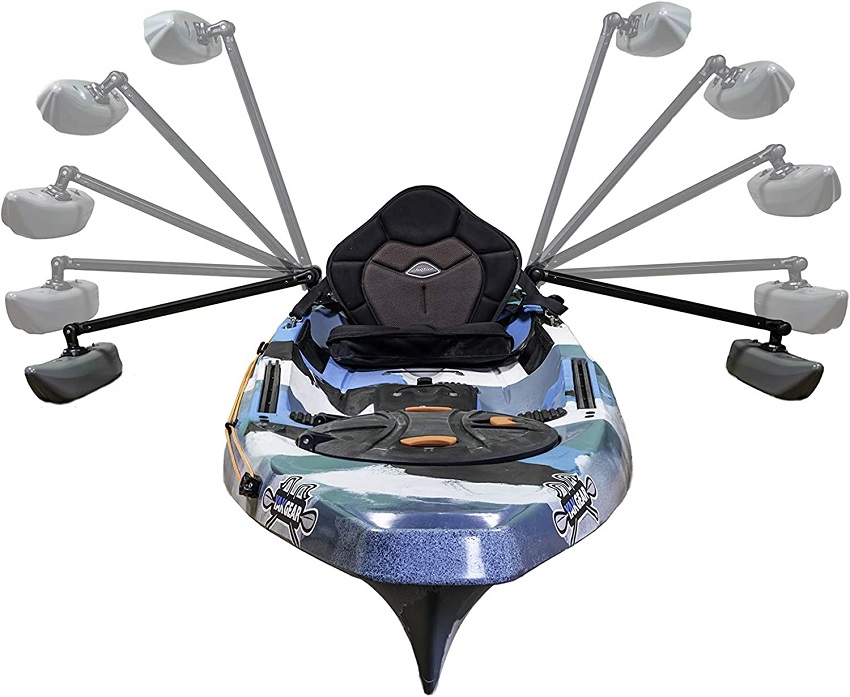
Materials: Aluminum arms, hard plastic float base
Length: 30 inches (76.2 cm)
Weight: 6.8 lbs (3 kg)
If you’ve got a RAILBLAZA base system on your kayak, then you’re good to mount this kayak outrigger in seconds. It’s designed to be compatible with most kayak brands and sizes, so you can use it for fishing, hunting, sailing, or just casual paddling. The pre-installed threading makes it a breeze to mount and dismount without having to remove the RAILBLAZA base.
The two outrigger arms are adjustable so you can set it to the desired length, keeping it out of the way of your paddles. The float bases are on the shorter side—just 30 inches—but their hardshell design makes them incredibly sturdy and resistant to damage. Best of all, they can be raised independently of each other so you can lift them out of the way of passing watercraft or a dock.
The main drawback to this particular kayak outrigger is that it’s so popular it often sells out and remains out of stock for days/weeks at a time. However, they’re compatible even with canoes and any kayak loaded with up to 350 pounds, making them the most versatile (and reliable) of the kayak outriggers on our list.
What We Like:
- Compatible with any kayak that has a RAILBLAZA system
- Easily mounted/dismounted, deploys independently of each other
- Includes all mounting hardware
- Adds excellent stability
What We Don’t:
- Often sold out/unavailable
- Place a lot of stress on gear tracks, which could bend them
Scotty Kayak Stabilizer System
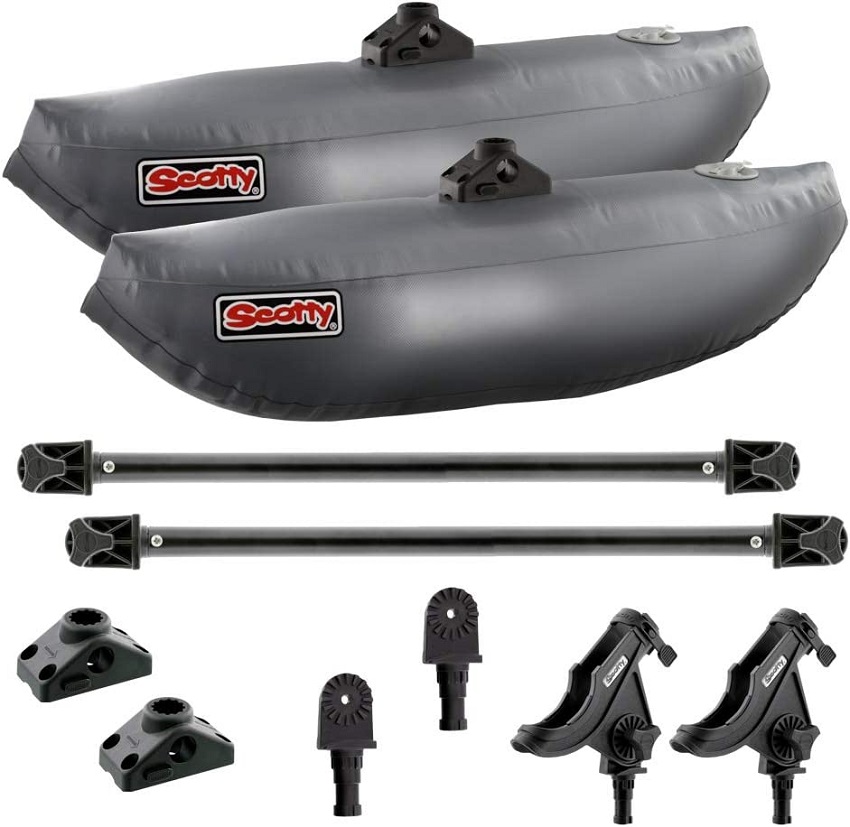
Materials: Anodized aluminum arms, PVC bladder float base
Length: 34 inches (86.36 cm)
Weight: 10 lbs (4.53 kg)
This outrigger “stabilizer system” is absolutely user-friendly, from its universal compatibility to its portable, collapsible design and inflatable float bases. Made in Canada, they use tough anodized aluminum to ensure the arms have more than strength enough to withstand even the harshest sailing and paddling conditions, and rugged PVC bladders capable of enduring a great deal of wear and tear.
The “unique assembly system” is actually incredibly easy to add and remove: locking brackets secure the arms in place, but can be quickly unlocked when you want to dismount the arms. Each arm adds an extra 30 pounds of buoyancy to the kayak and maximizes stability even on choppy waters. Use it for fishing, hunting, or sailing, and trust you’ll always stay steady and upright.
On the downside, the fact that you can’t adjust them means you have to learn how to correctly paddle, rather than adapting them to your paddling stroke. Their mounting placement at the rear of the boat means they’re pretty much impossible to remove unless you can stand up and turn around (very awkward!).
What We Like:
- Sturdy design, puncture-resistant bladder
- Easily mounted to virtually any kayak/mounting system
- Excellent buoyancy, minimal weight
- Affordable price and good quality
What We Don’t:
- Non-adjustable system
- Placement makes it impossible to remove them while paddling
Spring Creek Manufacturing Hydrodynamic Canoe Stabilizer Float Package
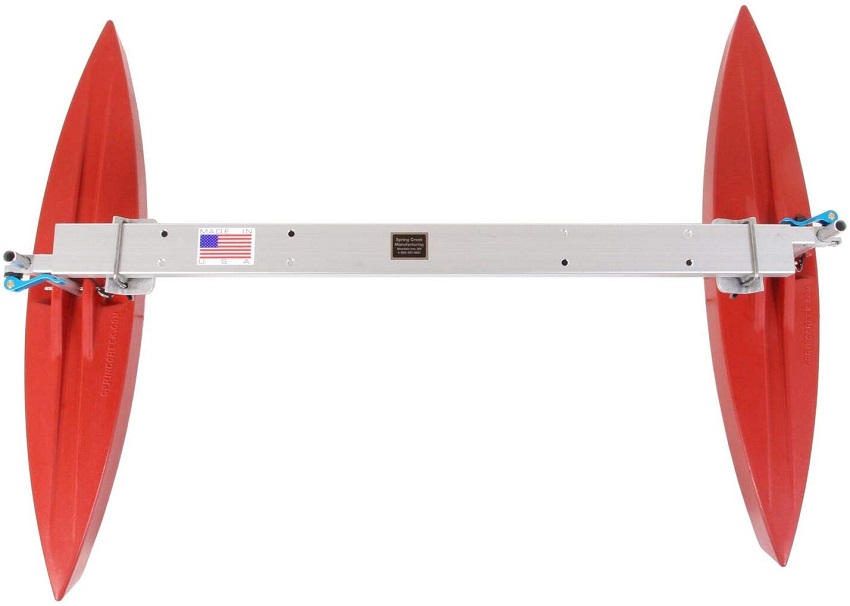
Materials: Aluminum crossbar, sturdy plastic floats
Length: 37 inches (94 cm)
Weight: 15 to 16.5 lbs depending on crossbar size (6.8 – 7.5 kg)
Let’s make one thing very clear about this outrigger: it’s designed specifically for canoes, not kayaks. In order to make it compatible with your kayak, it’s going to take some DIY skills to adapt either the outrigger or your kayak mounting hardware to accommodate it. Because of this, once you mount it, it’s not at all adjustable or easily removable.
However, thanks to its construction, it’s the sturdiest, most solid of the outriggers on our list. The crossbar is made with sturdy aluminum and is designed to lock in place to ensure the hard-shell floats are securely connected. You can actually extend the crossbar length (before it’s mounted and on the water) an extra 20 inches on either side to ensure it stays out of the way of your paddling stroke.
On the downside, it’s a bit heavier than some of the other mounting systems, and will definitely take up a lot of your kayak’s weight capacity (so you can’t transport as much gear). However, given its design and durability, it’s well worth the added weight!
What We Like:
- Incredibly sturdy design and construction; will never break or crack
- Doesn’t require specific mounting hardware
- Versatile and easily adjustable (before launch)
What We Don’t:
- DIY skills and extra hardware needed to mount it to a kayak
- On the heavier side
- Pricey
Wave Armor KAYAK / CANOE STABILIZER KIT
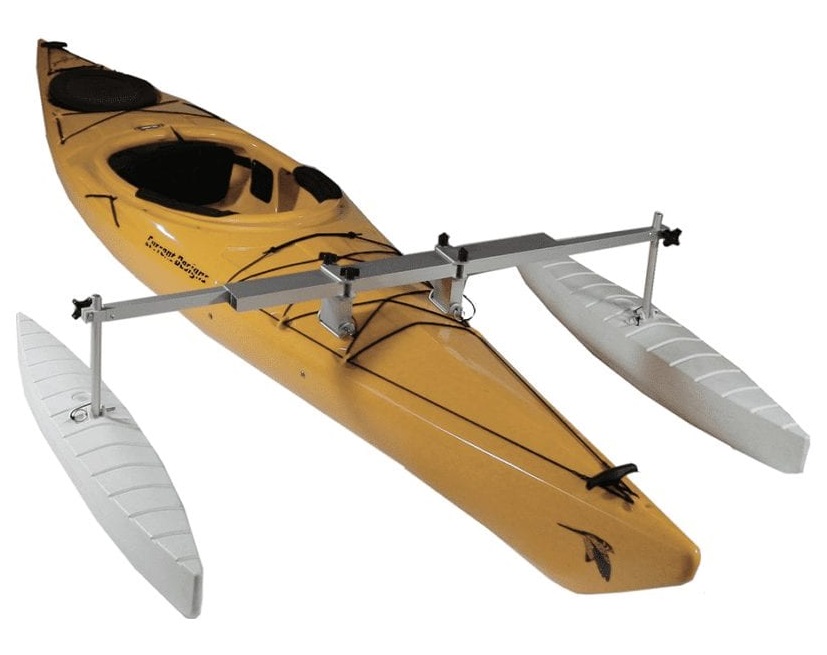
Materials: Aluminum frame, stainless steel components, polyethylene floats
Length: 43 inches (109 cm)
Weight: 20 lbs (9kg)
This system is designed to be universal enough that it can mount to both kayaks and canoes, with mounting hardware that doesn’t need an existing rail/mounting system, but allows you to secure it to whatever part of the kayak or canoe is the sturdiest. For anyone who has an inexpensive kayak and doesn’t want to spend a fortune on hardware, it’s a definite front-runner.
The frame is made from anodized aluminum with stainless steel components (at the joints/locking mechanisms), and floats are made from sturdy polyethylene that can withstand serious abuse from rocks, docks, and sea creatures. The arms are extendable and the frame itself can actually be adjusted to point the arms up or down as desired. Thanks to the over-sized 43-inch floats, you’ve got maximum stability as long as you’re on the water.
However, some customization may be needed to secure the frame to your kayak. The lack of user reviews available online makes it difficult to know about (and prepare for) any other issues you might encounter.
What We Like:
- Universal design compatible with a wide range of kayaks and canoes
- Incredibly durable hardware and locking components
- Extendable arms
- Easy to mount
What We Don’t:
- Some customization/DIY adjustments may be necessary
- No user reviews
- Pricey
Wingman The Cargo Outrigger
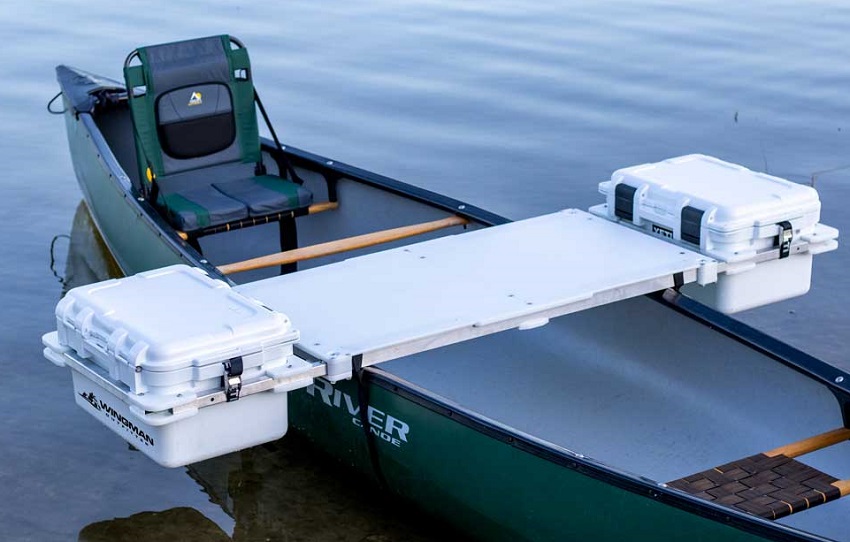
Materials: Aluminum frame, heavy-duty polyester webbing
Length: 20.5 inches (length of the Yeti GoBox™ Gear Cases) (52 cm)
Weight: Unspecified
If you want both stability and extra storage space, you’ll love The Cargo outrigger system by Wingman. Though it’s designed for canoes, it can be adapted (with some DIY work) to mount on a kayak. Once mounted, you get an excellent amount of extra stability plus plenty of additional storage for your gear—especially food and drink.
Instead of using floats, this outrigger system anchors two Yeti GoBox™ coolers to the end of the frame. These watertight coolers will offer the same buoyancy as a bladder or hard-shell float but also lets you store your beer, soda, water, and food close at hand. That way, if you ever get hungry, just pop open one of your outrigger “floats” and enjoy!
It’s definitely the priciest outrigger system on our list, and you do have to buy the coolers separate. However, any hunter or angler who gives this outrigger a try is sure to love it!
What We Like:
- Built for convenience and stability
- Compatible with all Yeti GoBox™ Gear Cases (and possibly other brands, too)
- Great for canoes, can be adapted for kayaks
- Incredibly sturdy; webbing rated for up to 2,500 lbs.
What We Don’t:
- Expensive
- You have to purchase the coolers (ALSO EXPENSIVE!) separately
- Must be adapted to mount on a kayak—some DIY skills needed
Brocraft Kayak Outriggers
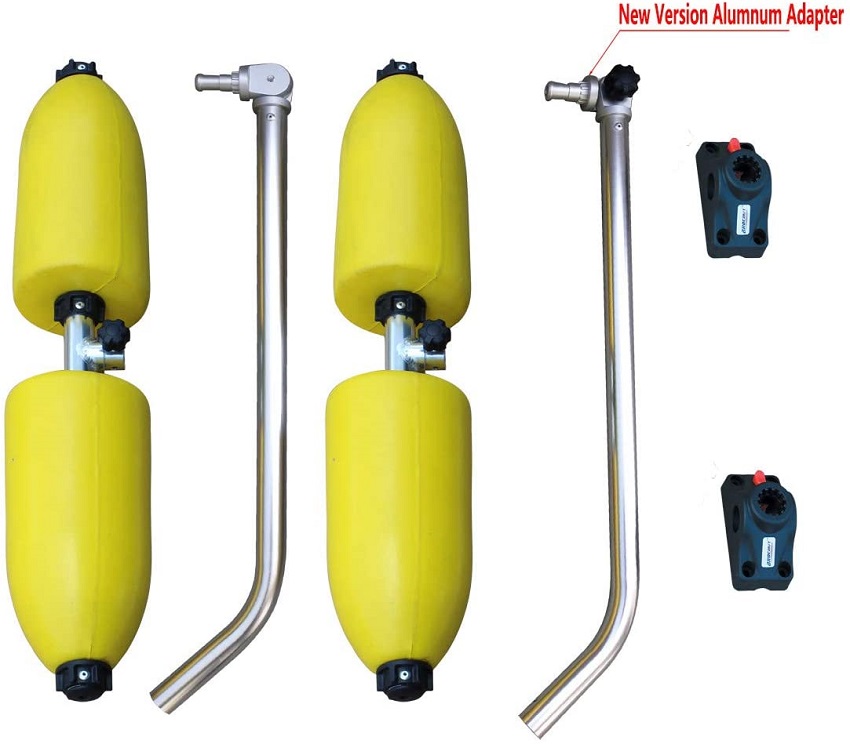
Materials: Aluminum arms, PVC floats
Length: 32 inches (81.28 cm)
Weight: 9 lb (4.29 kg)
Keep it simple, sweet, and cheap with this Brocraft outrigger system! It’s designed specifically for mounting on sit-on-top kayaks, including stainless steel mounting hardware that is easily secured in place on your existing frame/mounting solutions. The 32-inch aluminum arms extend just far out enough from the side of your kayak that they won’t get in the way of your paddling, and the PVC floats offer decent buoyancy despite their small size.
The arms aren’t adjustable or extendable, but the system is lightweight and user-friendly. It’s the perfect outrigger system for an inexpensive kayak (like your basic Pelican), turning a cheap sit-on-top kayak into an ultra-stable fishing platform. As long as it’s mounted well, you’ll find it’s nearly impossible to flip thanks to these bad boys.
Some users were less-than-pleased with the quality of the mounting hardware, though, saying it wobbled, failed to connect securely, or broke after a few uses. The outrigger system is also frequently sold out or unavailable online.
What We Like:
- Cheap, great for a newbie kayaker
- Easy to mount and compatible with most sit-on-top kayaks
- Provides excellent stability
- Perfect for fishing or a lazy day of floating
What We Don’t:
- Often sold out/unavailable
- Mounting hardware may suffer from a lack of quality control/poor design
Everything You Need to Know About Kayak Stabilizers
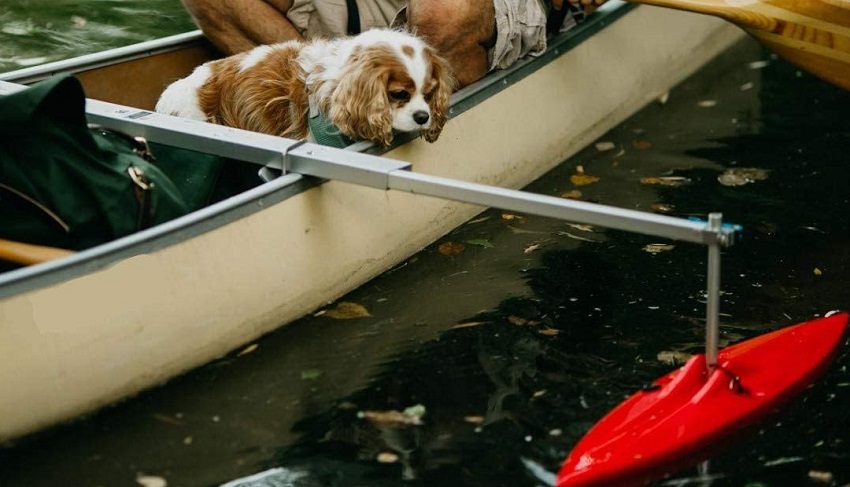
What is a Kayak Outrigger?
Let’s start off with the basics: what the heck is an outrigger?
To explain it simply, an outrigger is a flotation device attached to an arm or frame that extends out to the side of your kayak. Because it increases the surface space of your “platform” in contact with the water—specifically out to one or both sides—it provides stability, making it much harder for your kayak to tip over.
But it doesn’t stop there! Some outriggers are inflatable, which means they’re filled with air that provides buoyancy. Others are hardshell like your kayak itself, and some are made from a light material that floats on top of the water.
By securing an outrigger (or two) to your kayak, you make it harder to flip the kayak. Seriously, I dare you to give it a try! You can rock and roll all you want, but with a well-designed, securely attached outrigger, you’re going to have to work really hard to capsize the boat.
And if you can’t tip it, then you can bet your boots no wave will, either!
Why Do I Need Kayak Pontoons?
Let’s be honest: the average kayaker doesn’t really need an outrigger. Most of the time, you can get away with just the primary/secondary stability of the design, along with some smart paddling techniques to keep you stable even when the water is choppy.
However, there are a few times when stabilizers are either a game-changer or a must-have:
You’ve added a sail
If you install a kayak sail, what you’ve basically done is A) raise the kayak’s center of gravity, and B) increased tension overhead. When the wind picks up and fills the sail, that’s going to pull on the kayak, tipping it in the direction the wind is pulling. Add in the extra weight of the sail, and you’re much more likely to tip over—unless, of course, you’ve got an outrigger to keep everything balanced!
You’re angling for big fish
You know the kind, the bad-tempered, stubborn fish that struggle and make you fight to reel them in. The thrashing and pulling against the line can throw you off balance or cause your kayak to capsize. Adding an outrigger just increases the stability of the kayak’s “platform” so you won’t tip over. Fishing kayaks with an outrigger are perfect for angling for big fish from a standing position.
You’re big and tall
Taller, heavier kayakers may find that their kayaks are more prone to capsizing or tipping because they’re so close to the weight capacity. Anytime they stand, shift, or move around, their risk of capsizing increases. Adding an outrigger, however, will compensate for the extra weight and/or height.
You want to carry extra gear without losing stability
Let’s say you’re planning a multi-day kayak camping trip, or you’re gearing up for a long ocean trek. You need to bring a certain amount of gear for the trip, but if you fill up the kayak too much (with too much weight), your capsize risk is exponentially higher. Not with an outrigger, though! The stabilizers actually add buoyancy along with stability, so you’ll be able to carry more gear (on the kayak or even mounted to the outrigger arm/frame) for that long trip.
Pros of Kayak Outriggers
- Greater stability
- Lower risk of tipping over
- More gear carrying capacity
- Solid platform for fishing or hunting
Cons of Kayak Outriggers
- Extra drag will slow you down
- Harder to steer/handle
- Some models are pretty bulky
Best Kayak Pontoons: The Buying Guide
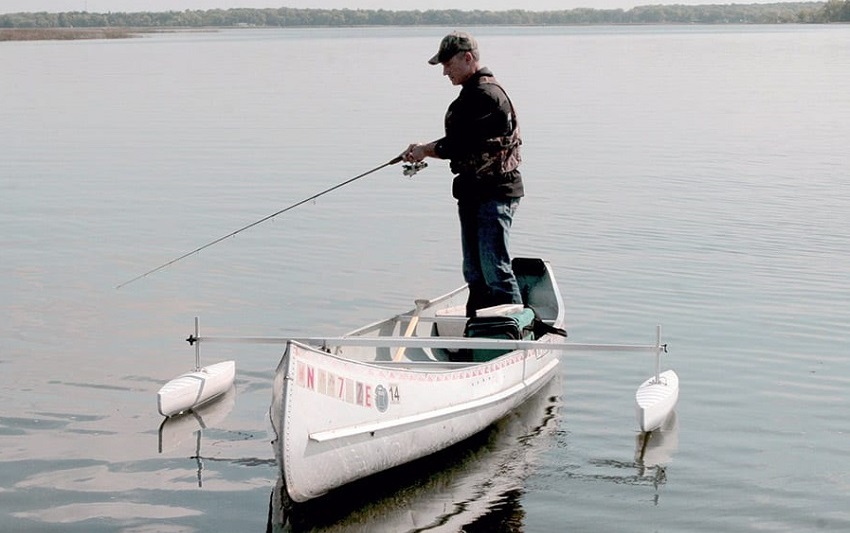
Still interested in an outrigger for your kayak? Here are all the factors to consider when shopping for kayak stabilizers:
Types of Kayak Stabilizers
Kayak outriggers come in two basic types:
Inflatable Kayak Outriggers
Inflatable stabilizers are typically made using some form of soft PVC or tough plastic. These are easily inflated (you can just blow them up yourself with no added equipment needed) and deflated, and can be stored easily in your kayak when not used. However, the exterior membrane, though made from a tough material, isn’t totally puncture-proof. Sharp rocks, coral, a struggling fish, or even an errant-cast treble hook might tear it.
Hardshell Kayak Outriggers
Hardshell kayak pontoons are typically made from thermoplastic/rotomolded plastic, hard PVC, or fiberglass. On the plus side, these are incredibly durable and typically last significantly longer than your average inflatable. However, they’re heavy, unwieldy, and can’t be stored, so you’ll always be using them until you hit dry land and can remove them.
Material
Kayak pontoons are typically made in two parts:
- The frame is usually built from aluminum or stainless steel, metals that are rust-resistant and won’t corrode (easily) with regular exposure to salt and fresh water.
- The outrigger itself is usually made from PVC or plastic (for soft-shell inflatables) or hard PVC/polyethylene (for hard-shell inflatables).
Some may also include nylon ropes/cords to deploy the outrigger.
Size
The size of the outrigger will have a direct impact on its buoyancy. Essentially, the longer and wider, the more A) surface area is in contact with the water and B) air it can hold (for inflatables).
Typically, the “floating” part of the outriggers is roughly 30 to 36 inches long, though you can find some larger or smaller options if needed. 30 to 36 inches is usually enough to provide sufficient buoyancy to increase your kayak’s stability.
Of course, another size factor to consider is the length of the outrigger arms. Typically, they’ll extend out far enough that they won’t interfere with your paddling stroke. However, for bigger/taller paddlers, you may find that some shorter outrigger arms aren’t quite long enough, and may not provide enough stability. It’s a factor to keep in mind when considering the kayak outrigger options on our list below.
Compatibility
One major factor to consider is whether or not your kayak can accommodate a mounting system.
Not all kayaks are compatible with outrigger mounting systems. They are designed without the rails, scupper holes, or hardware necessary to secure the outrigger frame. Or, even if they do have hardware, it’s not the right hardware for the specific mounting system.
It may take a bit of research to confirm whether the stabilizers are compatible with your kayak, or you may have to search reviews on YouTube. If all else fails, you might have to order them and test them out for yourself to be sure.
Thankfully, most kayak outrigger manufacturers have good return policies, so you can get a refund if it just doesn’t fit and you can’t figure out how to adapt the hardware to work!
Note: You can always adapt the kayak to accommodate a kayak outrigger if you’ve got the DIY chops. Watch this video from HobieKayakTech for an example:
Buoyancy
Size plays a big factor in buoyancy (the larger the outrigger, the more buoyant it is), but so does the type. Smaller inflatable outriggers may be more buoyant than larger hard-shell outriggers because they’re filled with air, rather than just using lightweight, low-density material.
However, bear in mind that the more buoyant outriggers will also be the slower ones. The larger and bulkier the outrigger, the more it will drag on your kayak. This is why outriggers are usually paired with sails because the added speed provided by the sail compensates for the extra weight of the outrigger, just like the added stability of the outrigger compensates for the sail’s top-heaviness.
Moveable vs. Fixed Stabilizers
A moveable outrigger is great for those who want to be precise about the placement of their outrigger. With a moveable system, you can decide exactly where on your kayak to mount the frame, and you can shift its placement in order to determine the most comfortable, convenient location.
As expected, of course, movable systems tend to be pricier than fixed systems. Fixed systems are designed to be mounted to one place on the kayak and don’t offer the option to adjust placement. They’re less versatile, but cost less, too.
Deployable Kayak Pontoons
One very cool feature of some kayak outriggers is that they can be lifted/removed when not in use, but easily deployed when you want to add stability.
For example, the YakGear Kayak & Canoe Outriggers feature a deployable design. This is great for anyone who wants both speed and stability. When you want to zip across the water, lift the outrigger arms and secure them in the upraised position. When you’ve reached your destination and want to fish/hunt, you can lower the arms to the water and enjoy the added stability.
Storage/Transportation
Whether inflatable or hard-shell, you need to know that kayak pontoons are far from small. Inflatable outriggers may be designed to deflate and roll up, but the arms that secure them to your kayak will still be solid poles that have to be stowed beside your seat or lashed to the deck.
And the hard-shell design is even less stowable! Even if they’re designed to be removed mid-paddle, they’re bulky and won’t fit in your storage compartments or even on your deck. You’re better off just keeping them in place and accepting the reduced speed.
You’ll have to keep this in mind not only when out on the water, but also when transporting the kayak/outrigger to and from the water, as well as storing it at home. Inflatable outriggers tend to take up less space than hard-shell outriggers, so they’re a better choice for anyone with a compact vehicle or limited storage/transportation space.
User Skill
This is always a factor to keep in mind when considering any addition to your kayak.
Just like adding a sail, installing outriggers will add a new element of complexity to your paddling. All those cool tricks that allowed you to zip through the water and pick up serious speed will no longer work because the outriggers reduce speed and steering/handling.
If you’re a first-time/newbie kayaker, you may find yourself struggling to handle a sail, keel, and outrigger all at once. You’re better off testing your additions close to shore/in shallow, calm waters before taking it out for a serious trip out on the ocean or on choppy waters.
Freshwater vs. Saltwater Use
Kayaks are designed for both fresh and saltwater use, but their accessories may not be. Some use materials that deteriorate, decompose, or corrode more quickly when exposed to saltwater.
For example, marine-grade aluminum holds up much better to saltwater than stainless steel, so a kayak outrigger made using aluminum will be far better for deep-sea fishing. Plastic corrodes quicker than PVC, so any saltwater-friendly outrigger will be made using PVC (soft for inflatable, hard for hard-shell).
That’s not to say that you can’t use any outrigger on saltwater. Even if your stabilizers use materials better suited to fresh water, you can still take them out for a saltwater trip. However, make sure it’s only an occasional trip, and that you wash them down thoroughly with fresh water after each use.
However, if you plan on using your kayak outrigger mostly on saltwater, make sure to buy one made with saltwater-resistant materials (like marine-grade aluminum and PVC).
Durability
Corrosion-resistance is just one of the factors to keep in mind when evaluating the durability of a kayak outrigger. You also want to evaluate its puncture-resistance (which is where hard-shells win over inflatables), the durability of its mounting hardware and deployment lines, and the strength of the connections between the outrigger arms and floating components.
A well-designed pontoon can bear up under the weight of heavy winds and choppy seas, but a poorly designed outrigger built from crappy, cheap materials may break and leave you in serious trouble out on the water.
Cost
The “cost” factors in not only the price you’ll pay, but how long the outrigger will last.
Ideally, you want to find an outrigger that is A) affordable while still being B) very durable and well-designed.
Reading user reviews—specifically the 1, 2, and 3-star reviews—to see what components/hardware malfunctioned is a great way to find out what flaws there are in the design and construction of any kayak outrigger.
FAQs
If you plan on speeding through the water or covering a lot of distance as quickly as possible, then the answer is no. An outrigger will slow you down and make steering/handling incredibly difficult.
On the other hand, if you’ve got a kayak sail (particularly a tall L-shaped sail) installed, you may want to use an outrigger to compensate for the top-heaviness. A kayak outrigger can also turn your kayak into a platform stable enough for fishing and hunting standing up.
There is no real “should” in the equation. Outriggers are typically 30 to 36 inches long, but you can find some in longer and shorter sizes according to your needs/preferences. It’s all about finding the outrigger system that provides you the right amount of stability for your paddling activity.
You definitely can! Because the arms extend out to either side of the kayak, there is virtually no risk of the kayak tipping to port or starboard (unless a big wave hits you). You’re more likely to lose your balance and fall overboard than to tip the kayak because of the huge increase in buoyancy and surface contact with the water.
With great skill, the right materials, and plenty of time invested!
DIYing a kayak outrigger is a complex, lengthy subject that we just don’t have time or space to get into in this article.
But you can watch these two videos to see how it’s done and give it a try for yourself:

